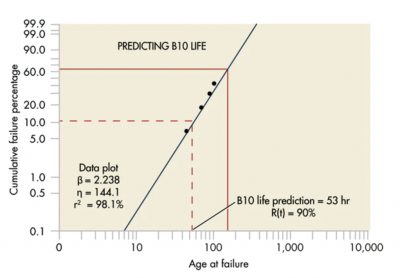
Giving customers confidence in the reliability of your products whilst meeting their expectations for service life and warranty is a surefire way to build customer loyalty and satisfaction. Using B10 life, we have a simple and effective metric to communicate the reliability of our products. Let’s find out more.
Overview: What is B10 life?
The B10 life metric originated with ball and roller bearing manufacturers and has since become widely used across a variety of industries. The B10, or Bearing life, nomenclature refers to the point at which 10% of units in a population will fail.
Alternatively, you can regard it as the 90% reliability of a population at a specific point in its lifetime. The B10 life metric gained traction among ball and roller bearing manufacturers due to the industry’s requirement that no more than 10% of bearings in a given batch should fail due to fatigue by a specific time.
B10 life is often quoted as a time, or a distance, or a number of actuation cycles — whichever is appropriate for the product and its application. Examples of B10 life could be:
- an electric motor may have a B10 life of 3000 hours
- a heavy-duty truck may have a B10 life of 1 million miles
- a pneumatic valve may have a B10 life of 500,000 actuation cycles
The calculation of B10 life is typically performed by statistical interpretation of test data, most commonly by Weibull analysis, and represented in a graphical plot as shown in the example below.
A thorough understanding of failure modes, in particular design failure mode and effect analysis, and root cause analysis is advisable to interpret the test data used to derive B10 life.

Image source: www.machinedesign.com.
2 benefits and 1 drawback of B10 life
Like many reliability and failure rate metrics, there are benefits and drawbacks to be aware of when calculating B10 life. Let’s explore some of these in more detail.
1. It’s a well-known and well-used industry reliability metric
Originating in the bearing industry and now widely adopted across most industrial sectors, the use of B10 life allows consumers the ability to review, compare, and interpret reliability data with relative ease.
2. You can use B10 life to set your warranty period
All companies strive to reduce their costs from warranty claims and improve customer satisfaction by delivering good product reliability. Knowledge of when a product will fail and a statistical analysis of the percentage of products that will fail at a given lifetime is hugely valuable when setting a realistic warranty period.
3. Testing to failure can be costly and time-consuming
Even though we may use a statistical approach to help cut down on sample size, we still need to evaluate products by testing for failure. This could be testing millions of actuation cycles, thousands of hours in service, or miles covered, all of which can be time-consuming and costly.
Why is B10 life important to understand?
By calculating and understanding B10 life, we can develop competitive products that are optimised for their application and meet customer requirements.
It gives customers a clear indication of product reliability
Whether it’s a domestic light bulb or a piece of high-value construction equipment, the B10 life metric allows the customer to make an informed decision on the suitability of the product to their application and requirements.
It helps us develop a robust maintenance and service strategy
Often, the B10 life is set as a requirement during product creation and development, developed from a critical to customer (CTC) flowdown. This allows us to develop a robust maintenance and service strategy, in parallel with product development, that supports the B10 life requirement.
It helps us balance the function and cost equation
Setting a B10 life requirement early in product creation and development allows us to make important decisions and trade-offs on both product function and cost to avoid over-engineering. Similarly, verification of B10 life can provide an opportunity to rebalance product function and cost, a strategy often deployed in the automotive industry after launch and during the product lifespan.
An industry example of B10 life
An industrial engine manufacturer had an opportunity to enter a new market sector and make its product available for stationary power generation. Two of the key requirements for stationary power generation engines are run hours without failure and product reliability. B10 life is a common metric used to assess and compare engine suitability and performance in the sector.
The B10 life metric was evaluated for the existing engine into the new stationary power application. As the engine would not travel any physical distance, the existing B10 life metric was changed from mileage to run hours. In addition a new duty cycle was derived for the physical testing, taking into account the specific engine speed and load running conditions.
Following an intensive test phase, engine run time data was interpreted using a Weibull analysis and a new B10 life was calculated. The warranty period and service and maintenance strategy were updated to reflect the newly calculated B10 life, and the engine was successfully launched for the stationary power generation market.
3 best practices when thinking about B10 life
As with many failure rate and reliability metrics, there are some key points to consider when calculating B10 life. Let’s explore three of these.
1. Measure and report the correct metrics
When we think about the life of a product or component, we can measure and report a variety of different metrics. These metrics could be service hours, mileage completed, number of cycles, or others, and careful consideration should be applied to what is measured and reported.
2. Data integrity underpins your calculations
Customers and consumers make important decisions based upon quoted failure rates. Reliability calculations and failure rate analysis are dependent upon conducting the right tests across a suitable sample size and measuring and capturing the right data.
3. Accelerated testing needs confidence in correlation
Often, the time to failure can be many thousands of hours, or millions of actuation cycles, which is both costly and time-consuming to replicate. Accelerated testing, where the test parameters are deliberately made more severe, is one way to reduce the burden of cost and time. However, this requires confidence in the correlation to real-world customer usage and duty cycles.
Frequently Asked Questions (FAQ) about B10 life
1. What is Bx life?
Bx life refers to the point at which x% of the units in a population will have failed. Commonly you may hear B10 quoted, B10 referring to 10% of the units in a population having failed at a specific point — e.g., at 1,000 hours.
2. Can I use statistical software to calculate B10 life?
Absolutely — there are a number of different software packages that can help you calculate B10 life. These typically use a Weibull analysis approach to generate the calculations.
3. Does B10 life mean 10% wear?
No, this is a common misconception that if we have a product with a quoted B10 life of 100,000 miles, it means there will be 10% wear or degradation of the product at this mileage. The correct meaning is that 10% of the products in a population will have failed by 100,000 miles.
A final thought to consider
Reliability analysis and determination of metrics such as B10 life can be the key differentiator when customers are making investment decisions. Taking the time to understand and calculate B10 life can bring the competitive advantage you need to secure the deal.